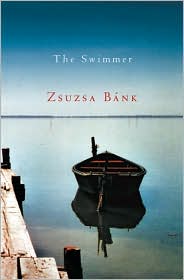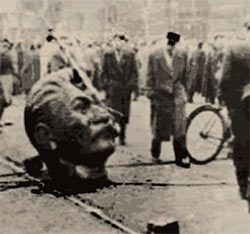“Time was passing now, yet nothing changed, at least not in the way we wished it would. When the clock struck the hour there was something almost mocking about it. Later I would hide stones, feathers, and coins in the houses we lived in and left. I hid them in closets, above door frames, behind windows, and in stoves. I never forgot a single one of my hiding places. I thought of them months later, years later.”
 Zsuzsa Bank, in her debut novel, accomplishes a remarkable feat. She writes a novel with virtually no plot at all, yet she makes us care about her characters and their lives. It is 1956 in Hungary, a time of enormous social upheaval. Living conditions are poor, workers are discontented, journalists are upset at their restrictions, and the governing Communist party is doing nothing to ameliorate the situation. When a rebellion, involving many students and young people breaks out and fighting begins, better-armed Soviet troops enter and start shooting. Over 250,000 people leave everything behind to seek new lives in other countries as refugees. One who leaves without any warning or goodbye is Katalin Velencei, wife of Kalman Velencei, and mother of young Kata, about eight, and Isti, about six, all of whom, abandoned, remain behind.
Zsuzsa Bank, in her debut novel, accomplishes a remarkable feat. She writes a novel with virtually no plot at all, yet she makes us care about her characters and their lives. It is 1956 in Hungary, a time of enormous social upheaval. Living conditions are poor, workers are discontented, journalists are upset at their restrictions, and the governing Communist party is doing nothing to ameliorate the situation. When a rebellion, involving many students and young people breaks out and fighting begins, better-armed Soviet troops enter and start shooting. Over 250,000 people leave everything behind to seek new lives in other countries as refugees. One who leaves without any warning or goodbye is Katalin Velencei, wife of Kalman Velencei, and mother of young Kata, about eight, and Isti, about six, all of whom, abandoned, remain behind.
Focusing entirely on the Velencei family, which lives outside the center of the rebellion, Bank constructs their lives—bleak, empty existences in which virtually nothing happens. Devastated by the desertion of his wife, Kalman, a man who has always loved swimming as an escape, now spends hours in a trance, staring at a picture of his wife, impervious to the barking of a dog and sometimes unable to recognize his own children. “We called it ‘diving,'” Kata says. “We’d ask each other, Has Father come back from diving?”

Heading first to visit his mother in the eastern part of Hungary, Kalman ends up in Budapest, where the children stay with their “godmother” Manci. Their father goes out at night, and the children do nothing, not even going to school. “It was as if someone had dropped Isti and me into syrup and forgotten about us,” Kata remarks. Lonely and longing for her mother, Kata begins to steal pretty-looking letters from other people’s mailboxes. Isti memorizes train schedules—the times and all the stops. When it is time to start school, they pack and move again, this time to stay still farther east with Kalman’s cousin Zsofi and her family. Soon there is another move, and another family to live with.
Throughout her story, Kata is unable to judge how long the family spends at any one place, saying only that it was “longer than one summer” or that it lasted for “several” falls– “Whether it was years or months doesn’t make any difference.” There is no schooling by which she can mark a year’s progress and no events which give real structure to her life. The only constants for her are her anxiety about Isti, who is clearly disturbed and getting no help, her desire to hear from her mother, and the family’s tendency to move without warning.
Bank divides the novel into a dozen separate sections, each one telling about life from the point of view of one of the people in the novel—Kalman,  Katalin (the missing mother), and the various characters who play roles in the lives of Kata and Isti as they move from family to family. Their grandmother does get letters from Katalin, who is in Austria and then Germany, and she reads them to Kata and Isti, but they do not hear from Katalin directly, and they clearly mourn her loss throughout the entire novel. The combination of their mother’s absence and the country’s own pessimism creates days of gray inactivity, and the events which are the “excitements” in their lives—seeing snow, riding in a car, reading a letter, visiting a train station, a wedding—are events of interest primarily because they break the monotony of the days.
Katalin (the missing mother), and the various characters who play roles in the lives of Kata and Isti as they move from family to family. Their grandmother does get letters from Katalin, who is in Austria and then Germany, and she reads them to Kata and Isti, but they do not hear from Katalin directly, and they clearly mourn her loss throughout the entire novel. The combination of their mother’s absence and the country’s own pessimism creates days of gray inactivity, and the events which are the “excitements” in their lives—seeing snow, riding in a car, reading a letter, visiting a train station, a wedding—are events of interest primarily because they break the monotony of the days.
A story with no plot, which illustrates the bleak and unexciting lives of a group of people, takes the risk that readers will find the novel itself bleak and unexciting. I found, however, that after the slow start, I began to care very much for these unassuming people and for Kata and Isti. The stories of their lives, so rooted in the mundane, take on particular poignancy as they come to represent the lives of legions of other ordinary people who, through the accident of war or rebellion, find their lives uprooted, their families torn, their homes vanishing, and all sense of “normalcy” evaporated. Ultimately, Bank’s recreation of the reality of two young children (and by extension the Hungarian people) achieves a universal significance which, for many readers, may transcend plot.
Notes: The author’s photo appears on www.litchannel.tv
The toppling of the Stalin statue in the 1956 revolution may be seen here: http://www.hungary.org.uk/events.asp?id=&y=2009&m=4
